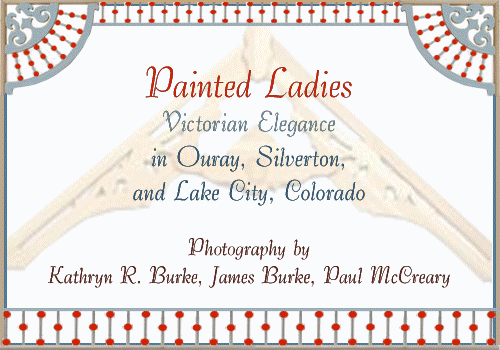Grand Old Gals of the Victorian Era
Story by Barbara Torke.
Photography by Paul McCreary, Kathryn and James Burke
All content © San Juan Publishing Group, Inc. All rights reserved.
 [SW Colorado] Colorful paint and fancy, “gingerbread” trim, much like the adornments of their nefarious “painted lady” namesakes (women entertainers in bordellos and other places of dubious reputation), gave these Victorian homes their nickname.
[SW Colorado] Colorful paint and fancy, “gingerbread” trim, much like the adornments of their nefarious “painted lady” namesakes (women entertainers in bordellos and other places of dubious reputation), gave these Victorian homes their nickname.
They appeared across the country in the late nineteenth century and early twentieth century. Pattern books became available of the Queen Anne style architecture that characterized them. The railroads brought fancy trim by the carload to the west. When the Queen Anne style went out of favor in the 1910s and 1920s, the great mining boom towns were left resplendent with the color, texture, and pattern of the hey-day of that dramatic era.
Oddly enough, most women who lived in these homes would never have deigned to speak to a real “painted lady,” whose presence was rarely alluded to by the “good” people who lived on the proper side of town.
The appellation probably derived from the dance hall girls, madams, and “ladies of the night” who tended toward flamboyance in their style of dress and adornment and wore gaudy makeup, mainly as self-advertisement. For many women, prostitution was their only available financial resource. Those women are long gone, but the fancy houses named after them, still stand proud on the streets of many western mining towns. However they got their names, their style of architecture, Queen Anne, is certainly evocative and picturesque.
American-style Queen Anne architecture of the 1870s is eclectic, incorporating leaded glass, open-bed and broken pediments, balconies, over-hanging eaves, and monumental chimneys. Furnishings featured Chinese-inspired early Georgian furniture, characterized by great expanses of wood with flowing lines. The polychrome paints used on the houses accentuate the asymmetrical style and highlight the patterns and textures created by the machine cut-outs that were shipped by train to the out-lying frontier from the eastern areas. The paint industry after the Civil War also contributed to this unique. Spindle detailing, wrap around porches, rounded towers, and gables are typical embellishments of the Victorian style—a style often referred to as decorative excess. It reminds us of some other painted ladies.
By 1870 balloon framing (uniform lumber cut by commercial mills) had replaced hand hewn logs. Advanced machine turned spindles, brackets, finished windows, doors, and decorations were shipped across the country on the expanding railroad network. Patterns and planning books, architectural periodicals, and pamphlets flourished. This led to many intricate additions, such as bay windows, oriels (out-hanging windows) and verandas.
Buildings of the time were built of wood, stone and brick. The colors were often earth tones, including sienna (earthy red), hunter green, ochre (dull yellow), and browns were popular. These colors accentuated the intricacies of the ornate grillwork and ornamentation.
During the ’20s and ’30s, after the Queen Anne style fell from popularity, whites and light colors were used to play down the dramatic, and to simplify painting.
But now, the bright ladies of the past are once again coming into favor. Accurate repainting and color choices can be researched for those wishing to restore a Victorian home to its former glory. Today’s painted ladies, tend to be in brighter colors, usually three, and their fancy, fussy trim is readily apparent, trim generally referred to as “gingerbread” at the local lumber yard. In keeping with their past opulence, gardens surrounding these homes are usually lushly excessive.
These grand old gals can be found in towns and cities around the country where there once was a display of the superfluous and ornamental. It recalls a time in our country’s history that was flamboyant, excessive, and just a little bit naughty.
Photography
Houses here and in accompanying slide show are in Ouray, Silverton, and Lake City, photographed in various seasons by Kathryn and James Burke, and Paul McCreary.
Notes
Painted Ladies is a term used for Victorian and Edwardian houses and buildings painted in three or more colors that embellish or enhance their architectural details. The term was first used for San Francisco Victorian houses by writers Elizabeth Pomada and Michael Larsen in their 1978 book Painted Ladies – San Francisco’s Resplendent Victorians. Michael Larsen and Elizabeth Pomada, “Painted Ladies- San Francisco’s Resplendent Victorian”s E.P. Dutton, New York, 1978.
References & Additional Links
Painted Ladies, Wikipedia
What are Painted Lady Houses? (suite 101.com) http://architecture.about.com/cs/housestyles/a/queenanne.htm
Victorian Home & Garden
Victorian Architecture examples – photos
